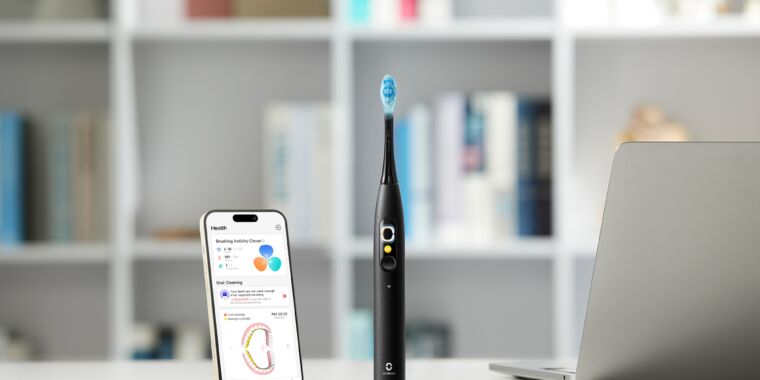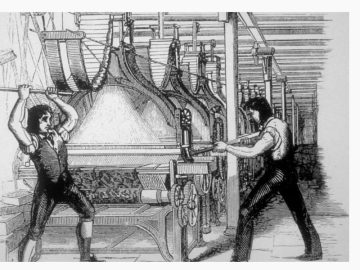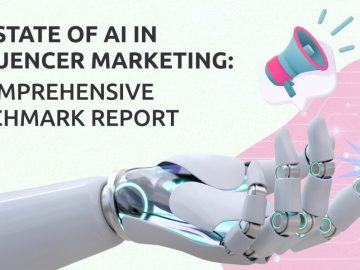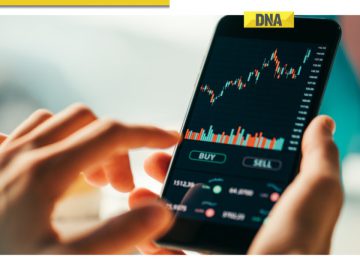Enlarge / Oclean’s X Ultra, released in July, has optional Wi-Fi connectivity.
Oclean
One of the most unlikely passengers on the AI gadgets hype train is the toothbrush. With claims of using advanced algorithms and companion apps to help you brush your teeth better, toothbrushes have become a tech product for some brands.
So-called “AI toothbrushes” have become more common since debuting in 2017. Numerous brands now market AI capabilities for toothbrushes with three-figure price tags. But there’s limited scientific evidence that AI algorithms help oral health, and companies are becoming more interested in using tech-laden toothbrushes to source user data.
AI toothbrushes
Kolibree was the first company to announce a “toothbrush with artificial intelligence.” The French company debuted its Ara brush at CES 2017, with founder and CEO Thomas Serval saying, “Patented deep learning algorithms are embedded directly inside the toothbrush on a low-power processor. Raw data from the sensors runs through the processor, enabling the system to learn your habits and refine accuracy the more it’s used.”
That’s pretty much how other AI toothbrush companies describe their products: There’s a vague algorithm working with an unnamed (likely cheap) processor and sensors to gather information, including how hard, fast, or frequently you brush your teeth. Typically, Bluetooth connectivity enables syncing this data with an app, purportedly letting users see interpretations of their brushing habits and how they could improve.
Kolibree now licenses its technology to Colgate-branded AI toothbrushes. The associated app, Colgate Connect, allows users to order Colgate products, sometimes at a discount. Other companies selling “AI toothbrushes” with connected e-commerce apps are Procter & Gamble’s (P&G’s) Oral-B, Philips, and Oclean, which announced a new tech-equipped toothbrush in July. Unlike many other toothbrushes, Oclean’s X Ultra can work with Wi-Fi.
An Oclean spokesperson told Ars Technica via email:
The toothbrush’s chip and accelerometer collect user behavior data. The embedded algorithm processes this data, and the brushing data is uploaded to the cloud in real time (no need to open the app once Wi-Fi is connected). Data processed on the toothbrush is displayed on the screen with limited dimensions, while cloud-processed results are shown on the mobile app with more dimensions and AI suggestions (based on recent or long-term brushing habits).
Assuming you could find an AI toothbrush that delivers on its claims by helpfully pointing out that you tend to miss your top-right molar, there’s reason to be skeptical about the necessity of such technology and the underlying motivations a brand may have in releasing an app-connected toothbrush.
AI toothbrushes help companies sell, develop products
Outside of toothbrushes, personal care brands have been seeking new ways to make money beyond selling units. As Stéphane Bérubé, CMO at beauty brand L’Oréal, put it, the industry can get value from selling services instead of just products. “I believe that the company that just sells products will not be successful,” she said at a 2018 marketing conference.
AI toothbrushes follow a similar approach. Toothbrushing tips act as a service, while the connected apps offer ways to potentially diversify a company’s business, make more revenue through product sales, and get an intimate understanding of how people use a product. The Oral-B toothbrush app, for example, can provide users information about their toothbrushing habits and recommend P&G products to buy while providing purchase links.
P&G has also discussed using AI in general as a way to get information that could help shape product development. As explained by P&G CIO Vittorio Cretella in a 2022 blog post, “algorithms can be defined to process consumer feedback on product changes and flag R&D engineers in real time, along with recommending adjustments accordingly.” As P&G’s R&D team has pointed out, traditional methods for collecting data on consumers, like surveys and focus groups, rely on self-reporting that can be inaccurate. Using tech to gather information about the way people use products is a way for corporations to address that flaw.





